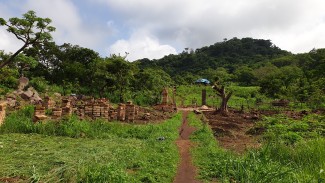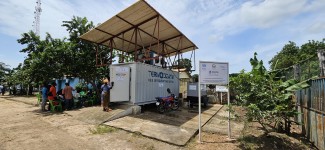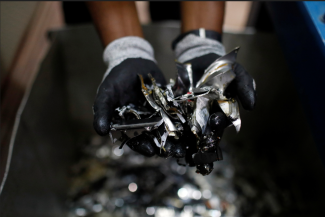International Monetary Fund (IMF) economists Martin Kaufman and Papa N’Diaye discuss trade, climate change mitigation and technology in Part 2 of their interview.
There are risks and there are opportunities in the current economic climate. Can you elaborate?
Martin Kaufman, Assistant Director, Strategy, Policy and Review Department: Unfortunately, risks dominate at this juncture related to trade and geopolitical tensions. These risks create uncertainty, affect investment and hinder global economic activity. The IMF’s World Economic Outlook emphasizes the need for cooperation in order to resolve these tensions. Traditional monetary and fiscal policy levers, as well as prudential policies to contain financial risks, are important to ensure growth and stability. But constructively resolving trade tensions is essential to unleash the global economy’s potential.[1] The multilateral trading system has been very important for emerging and developing economies who are key beneficiaries from a rules-based system. Therefore a durable resolution of tension rooted in a strengthened multilateral trading system would be of significant importance to all.
The IMF’s Fiscal Monitor Report for October 2019 discusses ways to combat climate change. Many least developed countries are bearing the brunt of global warming. What can they do?
MK: The report highlights that there is a significant underpricing of carbon emissions, which creates an unsustainable situation. And it raises the urgency of addressing climate change, including through carbon pricing. For example, in several cases the current pricing is in the single digits per ton of carbon dioxide but it should be closer to US$75 per ton. So carbon pricing is well behind what would be needed to address climate change. The report highlights the challenges ahead, which are very significant. Addressing climate change will have major implications, including distributional effects across countries, sectors and people. And since climate-related natural disasters will affect countries differently, not all may have the resources to deal with those risks. This involves the capacity to prepare and cope financially and in terms of better infrastructure.
Carbon pricing is well behind what would be needed to address climate change.
Martin Kaufman, Assistant Director, Strategy, Policy and Review Department. IMF
Papa N’Diaye, Division Chief, Regional Studies Division, African Department: This is an area where multilateral cooperation is critical. You have countries like South Africa, which if they were to apply the carbon pricing you would end up with electricity prices rising by 89% or something. And South Africa is dealing with huge unemployment and our forecast indicates declining incomes over the medium term, so these are countries that contribute the least to global warming and yet are likely to be impacted the most.
There needs to be a framework to address the distribution of resource and mitigation policies and it cannot be seen in a vacuum, it has to be seen as well in the context of what is happening with trade. For example, in sub-Saharan Africa there’s this big push for the African Continental Free Trade Area (AfCFTA) which will remove tariffs on 90% of goods in the 55 countries in Africa. These countries are not contributing that much to carbon emissions but you can imagine a scenario where that wouldn’t be the case as they develop.
So how do you design the trade system to take that into account? AfCFTA I think changes the calculus because you are moving from states with a very small population of 10-15 million to a whole continent that’s home to 1.2 billion people. So this opens up potential for these countries to integrate and not only among themselves but within the global value chain and with that we need to think about the trade policies that facilitate the transfer of technology to mitigate some of the carbon emissions that will come with development.
Today, least developed countries are confronting both the global economic slowdown and the risk they are left behind by technological advances that underpin much growth. How can these countries ensure they are not left behind, and who else needs to be part of the solution?
PN: We have done some work looking at the future for Africa and how technology could impact the region. The negative scenario would see this as perhaps a risk that the elevator be either shut down or the escalator pulled away when these countries need it the most to climb the development ladder.
But at the same time we see things that are quite encouraging. When you look at mobile banking, sub-Saharan Africa is a leader. You don’t need a brick and mortar bank for financial inclusion, now they have it at their fingertips and fantastic things are happening on that front. But it requires more investment – you need to have the network and the government needs to invest in that.
There are opportunities but the risks are there that they will be left behind with all the requirements in terms of skills and the technology and the substitution of low-skilled labor by robots. This will not necessarily be the case – it could be there is a way where the technology could allow a leapfrogging for these countries to go to next steps without going through the traditional development processes.
Purely from an economic perspective there’s a rationale for channeling capital towards developing economies and to get higher returns.
Papa N’Diaye, Division Chief, Regional Studies Division, African Department, IMF
MK: Your point is very important and should be a priority for all economies, big and small, poor and rich. We discussed the need for better institutions, structural reforms, upgrading policy frameworks, but there is also an urgent need to upgrade skills and education systems. This is more important than ever so that people are ready to take advantage of the opportunities that technological advance has to offer.
PN: If you look at what’s happening with the advanced economies and the state of the global economy, most experts agree that there is a high likelihood that we are stuck with low interest rates for a long time. Now what does it do to the pension system, insurance companies and so on? At the same time you have opportunities for investment in developing countries, like all of the Sustainable Development Goals could be transformed into asset classes that would provide higher returns so it becomes a win-win situation.
I’m not talking about this as Official Development Assistance, this is purely from an economic perspective there’s a rationale for channeling capital towards developing economies and to get higher returns. Of course, if there are requirements in terms of de-risking, for example, there might be some difficulties in how you set things up to make sure the investment is secure. All of that could be dealt with but we need to go beyond the traditional way of thinking and this is not about debt-creating flows, this is equity investment, this is what I think we should be thinking of.
If we are looking for high yields and at the same time resolving all of these development challenges, everybody has to gain from it. The continent will have the largest labour force in the world by 2030 or 2040, and a young labour force when the rest of the world will be aging. We have to create a situation where the jobs people need are there. The status quo is not tenable.
--------
This interview was conducted before phase 1 of the US-China trade deal was signed on 15 January 2020.
------
This is the second in a two-part series. Part I can be found here.
If you would like to reuse any material published here, please let us know by sending an email to EIF Communications: eifcommunications@wto.org.



